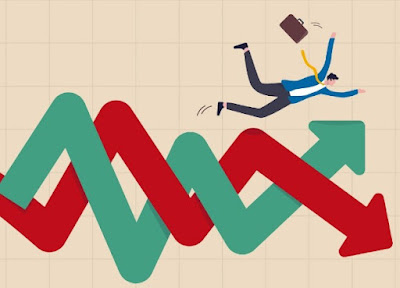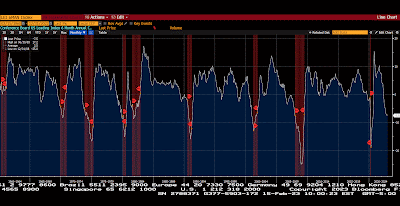Overview: On the heels of a dramatic jump in US job creation and firmer than expected year-over-year CPI, the US reported a larger than expected jump in retail sales and a strong recovery in manufacturing output. Few think that economic momentum that the recent data implies can be repeated, the "no landing" camp has gained adherents. We suspect that says more about psychology than the economy. The US two-year note is threatening to snap a five-day 20 bp advance today and is coinciding with a somewhat heavier dollar tone. There is a batch of US economic data today, including PPI, weekly jobless claims, and housing starts and permits. Several Fed officials speak today, including St. Louis Fed's Bullard, who is among the leading hawks.
China reported new house prices did not fall last month. It is the first time it has said this since August 2021. Nevertheless, mainland equities bucked the strong regional advance following the recovering of US equities yesterday. Europe's Stoxx 600 is extending its advance for the fourth consecutive session, while US futures are slightly softer. Benchmark 10-year yields are mostly 1-2 bp lower, putting the US 10-year around 3.78%. A softer US dollar and interest rates are helping gold stabilize after falling to $1830 yesterday. The low for the year is closer to $1825. April WTI is steady after initially extending yesterday's recover from about $77.50 to about $79.75 today.
Asia Pacific
Japan reported a record trade deficit last month of about JPY3.5 trillion (~$26 bln), which was still a little smaller than expected as exports rose 3.5% year-over-year rather than fall 1.7% as the median forecast in Bloomberg's survey had it. In December exports has risen 11.5%. And Japanese imports rose a milder 17.8% rather than 20.6% as economists expected. Of note exports to China fell a little more than 17%, led by autos, parts, and notably chip-making equipment. Exports to the US rose 10.2% and by 9.5% to the eurozone. Separately, the Ministry of Finance reported that Japanese investors bought JPY716 bln of foreign bonds last week. It was the second consecutive week of purchases, and in the two weeks, Japanese investors bought the most amount of foreign bonds since August (JPY1.8 trillion).
Australia's jobs data disappointed, and the Australian dollar initially fell in response before recovering in the face of a broader pullback in the US dollar. Australia reported a loss of 11.5k jobs. Economists had expected a 20k increase. Moreover, it lost 43.3k full-time positions after growing a revised 14.4k in December (initially17.6k). The unemployment rate rose to 3.7% from 3.5%. The central bank delivered a 25 bp hike last week and the next meeting is on March 7. The futures market does not have another 25 bp hike fully priced in until the April 4 meeting.
The US dollar reached JPY134.35 yesterday, its best level since the year's high was set on January 6 slightly above JPY134.75. It is consolidating in a narrow range and held above JPY133.60, with chart support seen around JPY133.50. There are options for $3.2 bln that expire tomorrow at JPY135. The poor jobs data saw the Australian dollar retest yesterday's low near $0.6865, holding above the month's low set closer to $0.6855. Session highs were record in late Asia Pacific turnover around $0.6935, which stretched the intraday momentum indicators. Yesterday's high was by $0.6990. The greenback reached CNY6.8640, its best level since January 6 but retreated below yesterday's settlement to test the CNY6.8550 area in late dealings. Of note, the 50-day moving average has fallen below the 200-day moving average for the first time since May of last year. Meanwhile, the PBOC set the dollar's reference rate a little stronger than expected (CNY6.8519 vs. CNY6.8508). Lastly, as expected the Philippines central bank raised its policy band 50 bp to 5.50%-6.00%.
Europe
Recent developments provide an opportunity to review two internal European market developments. First, we note that the rightist government in Italy carried the local elections in Lombardy and Lazio. In the latter, it turned out the center-left government. Salvini's League gained ground in Lombardy, but the strain in the coalition is coming from Berlusconi blamed Ukraine war on Zelenskyy. Prime Minister Meloni has supported the EU's criticism of Putin and efforts to defend Ukraine. Still, the latest polls suggest Italian support for Ukraine as slipped over the past year, and slightly more than 40% support sending weapons to Ukraine. Still, Berlusconi's comments caused saw teeth-gnashing and cries of protest from within the EPP (European People's Party, the center-right coalition in the EU parliament). According to Politico, at members from at least nine countries have threatened to boycott the gathering planned shortly in Naples, if Berlusconi attends. Ahead of next year's EU parliament elections, there was a desire reach out to Meloni. Tajani, an ally of Berlusconi, Italy's foreign minister and deputy PM, has reiterated the government's support for Ukraine, which is endorsed by the EPP. EC President von der Leyen and the president of the EU parliament Metsola hail from the EPP. Italy's 10-year premium over Germany fell from a little above 250 bp in late September to almost 170 bp in mid-January. It spiked back to 200 bp at the start of February but is hovering in the 180-185 bp area. The two-year premium peaked around 70 bp in late September and fell to almost 27 bp in mid-January. It has traded mostly between 35-45 bp this month.
Second, after the euro rose above CHF1.0 for the first time since last July, the single currency has pulled back to around CHF0.9850. Switzerland reported higher than expected January CPI (3.3% year-over-year for 2.8%) and the core rate is above 2% (2.2%) for the first time this century. The SNB meets on March 23. It will have another inflation report (March 6) in hand before it meets. Still, a 50 bp move is expected, which lift the policy rate to 1.5%. The swaps market is pricing in one more quarter point hike, possibly in June, to reach the peak.
The euro has steadied after falling from $1.08 on Tuesday to $1.0665 yesterday. It reached almost $1.0725 today. Resistance is seen in the $1.0735-50 area, which may be tested in the North American session. The euro has set a few lows in the $1.0655-65 area this month, and stops are likely building below there. Sterling has also steadied today. It briefly traded below $1.20 yesterday for the first time in a week, though it has not settled below there since January 5. It recovered to around $1.2075 today. Initial resistance is seen by $1.21. The intraday momentum indicators are stretched late in the European morning, suggesting it may struggle as North American activity resumes.
America
Until February 3, the swaps market was not convinced that the Fed funds target would peak above 5% and now it is flirting with 5.25%. The prospect of a rate cut this year has fallen from a sure thing to about a 50/50 proposition. The upside correction in the dollar we anticipated may be of a greater duration and magnitude. The Dollar Index, which we had projected to test 103.80-104.00 could extend toward 105.50-106.50, for example. Still, we suspect the talk of "no landing" says more about market psychology that the real economy. January's snap back was outsized and unlikely to be repeated. The inversion of yield curves and fall of M2 herald foretell of economic challenges, even if with a lag. Tomorrow, the US reports the index of leading economic indicators. It has not risen since last February. It is off 7.5% over the past six months annualized and such weakness has clearly been associated with recessions (see above chart).
The Fed's Mester, Bullard, and Cook speak today. The key issue is whether the recent data has swayed officials to change what they saw as the terminal rate in December. Recall that seven officials thought it ought to be above the median 5.1%. Lastly, we note that President Biden will shortly nominate a candidate to replace Brainard, and vice chair of the Fed. Brainard, was rumored to have been a likely candidate to be Treasury Secretary if Clinton won in 2016 and is seen as a possible replacement if Yellen steps down next year. Reports speculate that the new Chicago Fed president Goolsbee, a former adviser to Obama, is a likely candidate for the vice chair role. Although the US talks about reforming the multilateral organizations, it seems most likely that the changes will not include breaking from tradition that lets an American lead the World Bank. The current president, Malpass has indicated plans to resign around mid-year, nearly a year before his term expires.
Before we get to the LEI, there are today's reports of PPI, housing starts and permits, weekly jobless claims and the Philadelphia Fed's February business survey. Producer prices have some components that economists use to fine-tune expectations for the PCE deflator due at the end of next week. In and of themselves, though producer prices may generate a muted market response. Sequentially prices may rise (in December the headline fell by 0.5% and the core rose by 0.1%), but the year-over-year pace is expected to continue to slow. Still, what is driving consumer prices are not so much goods as services (which typically are not resource intensive). Housing start are expected to have declined last month, which would be the fifth consecutive monthly fall, but permits, a leading indicator, are expected to snap a three-month decline with a 1% gain. Meanwhile, weekly initial jobless claims may have bottomed in late January around 183k. They rose for the first time in six weeks in the week ending February 3 and are expected to have risen to 200k last week. If true, that would translate into the first increase of the four-week moving average since early December. That said, it is this week's activity that will be reported next week that coincides with the monthly February jobs report.
The US dollar recovered from CAD1.3275 on Tuesday to CAD1.3440 yesterday, seemingly driven by US data and the volatility of US equities. A quieter tone has emerged today, and the greenback barely traded above CAD1.3400, where options for $470 mln expire tomorrow. Support is seen around CAD1.3340-50 today. The US S&P 500 still offers a reasonably good direction cue. The US dollar spiked from MXN18.50 to about MXN18.75 yesterday. But once again a bounce in the greenback was sold and it settled close to MXN18.5855. It is hovering near there and has spent little time above MXN18.60 today. It looks set to consolidate after setting 4 1/2-year lows. Chart resistance may be closer to MXN18.65, while the MXN18.55 area looks firm.
Tags: #USD,China,Currency Movement,Featured,federal-reserve,Italy,Japan,newsletter,Switzerland,US




























